ETF knowledge centre
ARE YOU READY TO TAKE YOUR ETF KNOWLEDGE TO THE NEXT LEVEL?
Overview of ETF Strategies
ETFs are cost-effective tools that can help you diversify a portfolio and execute a range of strategic and tactical options.
Every ETF strategy comes with its own purpose and risk profile. Investors should also be realistic about their own temperament and tolerance for risk. Some of the ETF strategies described here entail taking concentrated investment positions, so it's important to weigh the extra risks involved against the potential rewards.
Here's an overview of the ways investors can use ETFs:
Core allocation
Gain fast, precise and cost-effective access to a broad variety of asset and sub-asset classes to build a strategic core portfolio.
Portfolio completion
Fill gaps in a portfolio to broaden diversification, minimise benchmark risk or add exposure to specific market segments or factors.
Active/passive combinations
Combine index ETFs and low-cost actively managed funds for diversification and the opportunity for outperformance.
Liquidity management
Invest short-term in the market with ETFs while refining a longer-term investment view.
Transition management
Quickly gain market (beta) exposure while searching for new investment management.
Rebalancing
Manage portfolio risk and/or beta tilts in between rebalancing cycles.
Tactical adjustments
Over- or underweight certain asset classes, regions or countries.
Overlay management
Use a portfolio of ETFs to provide similar exposure to the strategic asset allocation but with additional liquidity (also known as liquidity sleeve).
Core allocation
Decades of research at Vanguard and elsewhere have shown that asset allocation – how you divide assets across broad asset classes – is the primary driver of a portfolio's risk and return.
One of the most famous of these studies in the Financial Analysts Journal – Determinants of Portfolio Performance (1986) by Brinson, Hood and Beebower – found that asset allocation accounts for 94% of the variation in returns in a portfolio, with market-timing and security selection accounting for only 6% (Figure 1). Vanguard research by Wallick et al. (2012) and Philips et al. (2014) supported these findings. It showed that, over time, the asset allocation decision was responsible for between 80% and 92% of the return patterns of balanced funds available to investors in five global markets: the US, Canada, UK, Australia and Hong Kong1.
Figure 1. Investment outcomes are largely determined by asset allocation
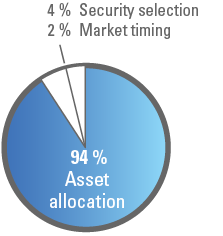
Source: Vanguard illustration, based on data from Determinants of Portfolio Performance (1986) by Brinson, Hood and Beebower.
A portfolio composed of broadly diversified ETFs can help ensure that performance and risk exposure are based primarily on your asset allocation decisions. In fact, holding even a small number of broad-market ETFs can provide a convenient and low-cost way to diversify across asset classes for long-term investors (Figure 2).
Figure 2. Investors can diversify across asset classes with a small number of ETFs.

Source: Vanguard. Hypothetical portfolios are shown for illustrative purposes only and shall not be construed as a recommendation to buy or sell any security or financial instrument, or an offer or recommendation to participate in any particular trading or investment strategy.
Over time, the varying returns of different asset classes will cause nearly every asset allocation to change, resulting in a change to the portfolio's risk and return characteristics. That's why we believe periodic portfolio rebalancing is important. ETFs' trading flexibility and ease of access make them ideal tools for rebalancing a portfolio back to its strategic asset allocation.
1Percentages represent the median observation from the distribution of percentage of return variation explained by asset allocation for balanced funds. The results by country were as follows: US 92%; Canada 88%; UK 80%; Australia 90%; and Hong Kong 86%.
Points to consider
In a diversified portfolio, gains from some investments may help offset losses from others. However, diversification does not ensure a profit or protect against a loss.
An all-index portfolio removes the potential for market outperformance that can result from active management or individual security selection.
All ETFs are subject to market risk. Global ETFs involve additional risks, including currency fluctuations and the potential for adverse developments in specific countries or regions. Bond ETFs are subject to interest rate, credit and inflation risk.
Portfolio completion
Portfolio completion may be used strategically or tactically to fill a gap in a portfolio.
For example, an investor may have little or no exposure to certain asset classes, market segments or sectors. Rebalancing to diversify the portfolio or transitioning into a model portfolio may not be possible because of trading restrictions or other issues.
In these cases, ETFs can be used to fill gaps until the portfolio can be rebalanced to the desired allocation. In the illustration, a value ETF fills a gap and increases the diversification of a portfolio that's heavily weighted toward growth equities.

Source: Vanguard. This hypothetical investment or portfolio strategy is shown for illustrative purposes only and shall not be construed as a recommendation to buy or sell any security or financial instrument, or an offer or recommendation to participate in any particular trading or investment strategy.
Point to consider
Greater diversification introduces the possibility of underperformance relative to a concentrated portfolio, but it also means less risk.
Active/passive combinations
Actively managed investments offer an opportunity for outperformance, but they also bring greater relative risk and unpredictability.
Low-cost passively managed investments typically reflect the risk and return characteristics of a given market segment but do not offer the opportunity for outperformance. Combining lower-cost active funds with index ETFs can achieve a balance between the two approaches.
Core-satellite approach
One way to do this is with a core-satellite strategy that employs indexing at the core of a portfolio and actively managed funds as satellites. This idea recognises the differences between index and active fund management and combines the best aspects of both approaches.
The indexed core provides a risk-controlled, low-cost way to capture market returns (beta) over the long term, while the actively managed satellites provide an opportunity for market outperformance (alpha).
| Active approach | Index approach |
|---|---|
|
|
Core-satellite methodology
The conventional view of core-satellite methodology (Figure 1) suggests that it’s prudent to use index funds for areas of the markets that are deemed efficient, such as large-cap shares. This view holds that actively managed funds make more sense to use in areas of the market that are considered to be inefficient, such as small-cap or emerging market equities. The thinking here is that active managers are more likely to succeed in these areas.
Figure 1. The conventional view
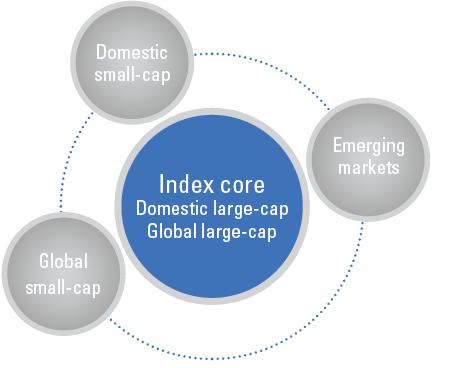
Source: Vanguard. This hypothetical investment or portfolio strategy is shown for illustrative purposes only and shall not be construed as a recommendation to buy or sell any security or financial instrument, or an offer or recommendation to participate in any particular trading or investment strategy.
An alternative view of core-satellite investing (Figure 2) suggests that indexing is a powerful investment strategy in all market segments. As a result, the active/index decision should be predicated on an investor’s ability to identify low-cost, talented managers, not on the indiscriminate selection of active managers in apparently inefficient market areas. This view holds that skill in selecting active managers drives the success of a core-satellite portfolio.
Figure 2. An alternative view
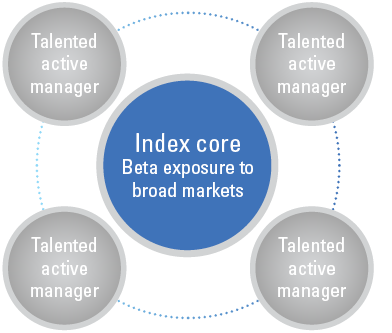
Source: Vanguard. This hypothetical investment or portfolio strategy is shown for illustrative purposes only and shall not be construed as a recommendation to buy or sell any security or financial instrument, or an offer or recommendation to participate in any particular trading or investment strategy.
Points to consider
There is no guarantee that a combined active/passive approach will be less risky than an all-active or all-index approach and will achieve comparable returns.
Whether they choose active or passive funds, investors should consider funds that have low overall costs to increase the probability of long-term success. Costs directly detract from investment returns.
Liquidity management
ETFs can also be a good option for an investor who has a large temporary cash position.
Such a cash position may tilt an investor's portfolio away from its targeted allocation to equities or fixed income. Over extended periods, that position can result in performance shortfalls relative to benchmarks or financial goals. Why? Historically, equity and fixed income markets have had more periods of positive returns than periods of negative returns. The longer the time period, the stronger this performance bias. Investing a temporary cash position in ETFs reduces the likelihood of such performance shortfalls.
Example: An active small-cap manager used to keep a cash buffer of around 3% to fund new trade ideas and meet frequent cash flow needs. This resulted in a significant cash drag of more than 2% due to strong momentum in equity markets. The asset manager decided to equitise the cash allocation with a small-cap ETF to help minimise the cash drag.
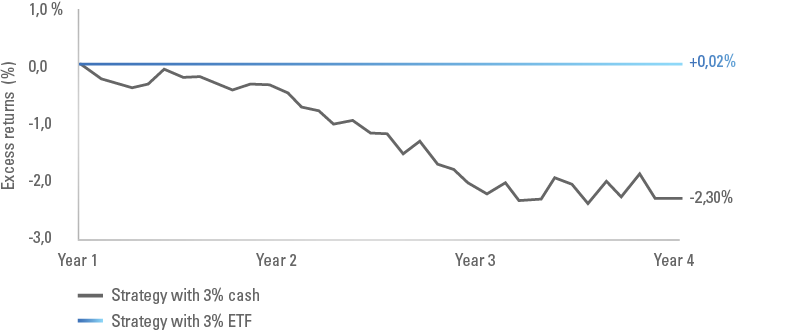
Source: Vanguard. This hypothetical investment or portfolio strategy is shown for illustrative purposes only and shall not be construed as a recommendation to buy or sell any security or financial instrument, or an offer or recommendation to participate in any particular trading or investment strategy. It assumes a positive market return over the four-year period. The figure -2.30% could be higher or lower based on the performance of the market in real life.
Points to consider
Equities/bonds could underperform cash during the transition period.
Trading costs may offset some of the potential advantages.
Transition management
ETFs can be a good option for an investor when transitioning between managers.
Sometimes investment managers have to be replaced. This may occur due to performance issues, a change in management style or because portfolio management is moved in-house. Searching for a new manager and transitioning the portfolio, even if in-house, takes time. This exposes the portfolio to a number of risks. Often the original portfolio will differ significantly from the new manager's desired asset allocation. There's a potential performance mismatch if portfolio assets are not invested in the markets, even for a short period of time.
ETFs can be a good option for maintaining market exposure and remaining fully invested during the search and transition process.
Example: A client decided to move an actively managed USD corporate bond portfolio from an external manager to an internal passive portfolio manager. The legacy portfolio was highly fragmented with many thinly traded positions. ETFs allow for in-kind creations so that large parts of the legacy portfolio could be delivered via a broker to the ETF manager. The ETF manager issued new ETF shares in exchange. The remaining bonds were sold in the cash bond market. After the new in-house manager was appointed, the client redeemed parts of the ETF positions in-kind to deliver the underlying basket of bonds to the new portfolio.

Source: Vanguard. This hypothetical investment or portfolio strategy is shown for illustrative purposes only and shall not be construed as a recommendation to buy or sell any security or financial instrument, or an offer or recommendation to participate in any particular trading or investment strategy.
Points to consider
Equities/bonds could underperform cash during the transition period.
Trading costs may offset some of the potential advantages.
Rebalancing
ETFs are ideal tools for rebalancing to maintain a portfolio’s strategic asset allocation.
Over time, the varying returns of different asset classes will cause nearly every asset allocation to change, resulting in a change to the portfolio's risk and return characteristics. That's why we believe periodic portfolio rebalancing is important. ETFs' trading flexibility and ease of access make them ideal tools for rebalancing a portfolio back to its strategic asset allocation.
Point to consider
In a diversified portfolio, gains from some investments may help offset losses from others. However, diversification does not ensure a profit or protect against a loss.
Tactical adjustments
Tactical investing involves deliberately overweighting or underweighting certain market segments or industry sectors based on your assessment of market or economic cycles.
Market-capitalisation-weighted ETFs offer an efficient way to target the desired tilt.
For example, if you believe that after a protracted period of outperformance by value stocks the pendulum is likely to swing the other way, you might invest in a growth-oriented ETF.
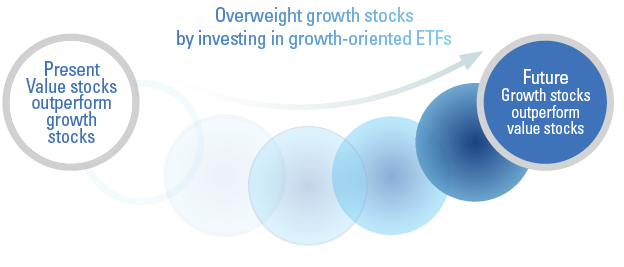
Source: Vanguard. This hypothetical investment or portfolio strategy is shown for illustrative purposes only and shall not be construed as a recommendation to buy or sell any security or financial instrument, or an offer or recommendation to participate in any particular trading or investment strategy.
Points to consider
You could end up doing worse than if you'd made no changes at all.
Whether buying or selling, you would have to be right about the direction of the market/economic cycle, the sectors that might profit from it and the timing of the investments.
Concentration in any security, industry sector, market segment, region or asset class can lead to greater risk relative to a diversified portfolio.
Overlay management
A portfolio of ETFs can be used to provide similar exposure to the strategic asset allocation but with additional liquidity.
Since the financial crisis, liquidity is a source of concern for many investors. One option to address this is to increase the allocation to cash. However, this might result in a performance drag compared with the strategic asset allocation benchmark. Alternatively, a certain percentage of the portfolio can be invested in ETFs mirroring the strategic asset allocation. As a result, the portfolio is fully invested but with additional liquidity.
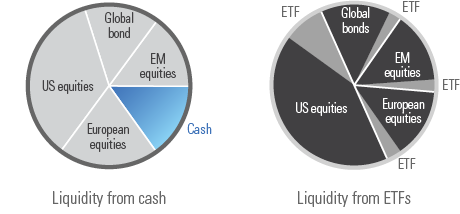
Source: Vanguard. This hypothetical investment or portfolio strategy is shown for illustrative purposes only and shall not be construed as a recommendation to buy or sell any security or financial instrument, or an offer or recommendation to participate in any particular trading or investment strategy.
Point to consider
Trading costs may offset some of the potential advantages.
Basics
Learn the basics of ETFs, including their history, how they compare to mutual funds and more.
Management
Learn about the different types of exchange-traded products, how index and active ETFs are managed and more.
Trading
Learn the basics of ETFs, including their history, how they compare to mutual funds and more.